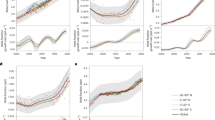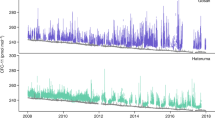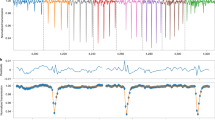Abstract
Concern that emissions of fully halogenated hydrocarbons may deplete stratospheric ozone through chlorine-catalysed destruction1–3 has prompted a search for safer chemicals. CHCIF2 (CFC-22) is a promising substitute as it contains only a single chlorine atom and is partially removed in the troposphere by reactions with hydroxyl radicals (OH) 4. Recognizing these facts, CFC-22 has been excluded from the controls under the Montreal Protocol29. The possibility of rapidly increasing use of CFC-22 suggests a need for careful atmospheric monitoring, especially as the atmospheric lifetime of CFC-22 is long but uncertain (12–28 yr (refs 3, 5)) and absorption by the strong CFC-22 infrared bands could contribute to greenhouse warming6,7. Here we report atmospheric CFC-22 measurements derived from ground-based solar spectra recorded between December 1980 and May 1988 which show that the CFC-22 total column increased at an average annual exponential rate of 7.8% ± 1.0% (2σ). Compared with other atmospheric data, these measurements indicate that CFC-22 is increasing at a more rapid rate than either CFC-11 or CFC-12, the two most abundant chlorofluorocarbons, but that the rate of CFC-22 increase is likely to have declined over the past few years.
This is a preview of subscription content, access via your institution
Access options
Subscribe to this journal
Receive 51 print issues and online access
$199.00 per year
only $3.90 per issue
Buy this article
- Purchase on Springer Link
- Instant access to full article PDF
Prices may be subject to local taxes which are calculated during checkout
Similar content being viewed by others
References
Molina, M. J. & Rowland, F. S. Nature 249, 810–812 (1974).
Rowland, F. S. & Molina, M. J. Rev. Geophys. Space Phys. 13, 1–35 (1975).
Wuebbles, D. J. J. geophys. Res. 88, 1433–1443 (1983).
Natn. Acad. Sci. Stratospheric Ozone Depletion by Halocarbons: Chemistry and Transport (Natn. Acad. Sci., Washington, DC, 1979).
World Met. Org. Rep. No. 11, Geneva (1981).
Ramanathan, V., Cicerone, R. J., Singh, H. B. & Kiehl, J. T. J. geophys. Res. 90, 5547–5566 (1985).
Varanasi, P. & Chudamani, S. J. geophys. Res. 93, 1666–1668 (1988).
WMO/NASA Atmospheric Ozone 1985; Assessment of Our Understanding of the Processes Controlling its Present Distribution and Change World Met. Org. Global Research and Monitoring Proj. Rep. No. 16, Ch. 3 (1986).
Rasmussen, R. A., Khalil, M. A. K., Penkett, S. A. & Prosser, N. J. D. Geophys. Res. Lett. 7, 809–812 (1980).
Khalil, M. A. K. & Rasmussen, R. A. Nature 292, 823–824 (1981).
Fabian, P. in The Handbook of Environmental Chemistry, Vol. 4/Part A (ed. Hutzinger, O.) 24–51 (Springer, Berlin & Heidelberg, 1986).
Fabian, P. et al. in Proc. Quadrennial Ozone Symp. Göttingen, West Germany (in the press).
Rinsland, C. P. et al. J. geophys. Res. 87, 11119–11125 (1982).
Rinsland, C. P., Boughner, R. E., Larsen, J. C., Stokes, G. M. & Brault, J. W. J. geophys. Res. 89, 9613–9622 (1984).
Rinsland, C. P., Levine, J. S. & Miles, T. Nature 318, 245–249 (1985).
Zander, R., Rinsland, C. P., Farmer, C. B. & Norton, R. H. J. geophys. Res. 92, 9836–9850 (1987).
Goldman, A. et al. Geophys. Res. Lett. 8, 1012–1014 (1981).
Murcray, D. G., Murcray, F. J., Goldman, A., Bonomo, F. S. & Blatherwick, R. D. High-Resolution Infrared Laboratory Spectra (Univ. Denver, 1984).
Herzberg, G. Molecular Spectra and Molecular Structure. II. Infrared and Raman Spectra of Polyatomic Molecules (Van Nostrand Reinhold, New York, 1945).
Plyler, E. K. & Benedict, W. S. J. Res. Natn. Bur. Stand. 47, 202–220 (1951).
Rasmussen, R. A. & Khalil, M. A. K. Antarct. J. U.S. 17, 203–205 (1982).
Rasmussen, R. A. & Khalil, M. A. K. Antarct. J. U.S. 18, 250–252 (1983).
Rinsland, C. P. et al. J. geophys. Res. 93, 12607–12626 (1988).
Zander, R., Stokes, G. M. & Brault, J. W. Geophys. Res. Lett. 10, 521–524 (1983).
Watson, R. T. et al. NASA Ref. Publ. 1208, Table C-8.1 (1988).
Khalil, M. A. K. & Rasmussen, R. A. in Baseline Atmospheric Program (Australia) 1985 (eds Forgan, B. W. & Fraser, P. J.) 26–29 (Dept. Sci./Bur. Met., Australia, 1987).
Rothman, L. S. et al. Appl. Opt. 26, 4058–4097 (1987).
Smith, M. A. H. NASA tech. Mem. 83289 (1982).
Johnston, K. Nature 329, 189 (1987).
Author information
Authors and Affiliations
Rights and permissions
About this article
Cite this article
Rinsland, C., Johnson, D., Goldman, A. et al. Evidence for a decline in the atmospheric accumulation rate of CHCIF2 (CFC-22). Nature 337, 535–537 (1989). https://doi.org/10.1038/337535a0
Received:
Accepted:
Issue Date:
DOI: https://doi.org/10.1038/337535a0
This article is cited by
Comments
By submitting a comment you agree to abide by our Terms and Community Guidelines. If you find something abusive or that does not comply with our terms or guidelines please flag it as inappropriate.



